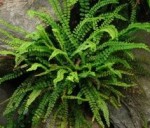 Some plants thrive in the cracks and crevices of wall. Traditional cottage gardens often had plants that seeded themselves into crumbling areas of walls where they grew and bloomed, adding color, form, texture, and sometimes even fragrance. Their ability to reseed and spread themselves where they found favorable growing conditions made them popular cottage garden plants and allowed them to add to the casual charm of the garden’s ambiance.
Some plants thrive in the cracks and crevices of wall. Traditional cottage gardens often had plants that seeded themselves into crumbling areas of walls where they grew and bloomed, adding color, form, texture, and sometimes even fragrance. Their ability to reseed and spread themselves where they found favorable growing conditions made them popular cottage garden plants and allowed them to add to the casual charm of the garden’s ambiance.
Here are five plants with summer interest that grew in the crumbling walls of traditional cottage gardens of the past.
 Jupiter’s Beard (Centranthus ruber)
Jupiter’s Beard (Centranthus ruber)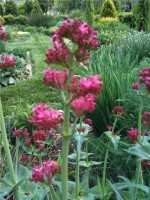
Jupiter’s beard, also called red valerian, is a long blooming perennial that may bloom from spring until fall if it’s faithfully deadheaded. It can grow to 3’ tall so can be quite eye-catching growing in a wall. Flowers come in white and a variety of pinks but the best shade is a rich crimson.
-
Type: Perennial
Color: White, pink, crimson
Light: Full sun
Soil: Average, well-drained, slightly alkaline
Hardiness: Zones 5-8
 Yellow Fumitory (Corydalis lutea)
Yellow Fumitory (Corydalis lutea)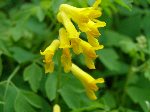
Yellow fumitory is the scamp of the garden, showing up everywhere. But when it finds a choice spot in the garden wall it shows its special charm to the greatest advantage. The blue-green foliage is delicate and fern-like, and the little yellow flowers have short spurs and are borne in small clusters through out the summer. A native of woodlands, yellow fumitory is relative of bleeding heart, and thrives in cool, moist places in sun and shade.
-
Type: Perennial
Color: yellow
Light: Full sun to partial shade
Soil: Rich, moist, well-drained
Hardiness: Zones 5-7
 Latin American Fleabane (Erigeron mucronatus/karvinskianus)
Latin American Fleabane (Erigeron mucronatus/karvinskianus)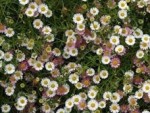
A native of Mexico and South America, this fleabane has naturalized in many places including the United States west coast. The bushy plants grow from a woody root and produce a mass of white daisy-like flowers that slowly change to deep pink so that at any one time there are flowers in many shades on the plant.
-
Type: Perennial often grown as annual
Color: White to pink
Light: Full sun to part shade
Soil: Fertile, moderately moist, well-drained
Hardiness: Zones 5-7
 Chimney Bellflower (Campanula pyramidalis)
Chimney Bellflower (Campanula pyramidalis)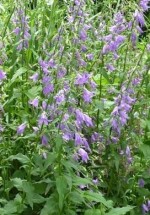
Chimney bellflower is a very tall plant that reseeds prolifically and enjoys settling into a suitable site in a wall in spite of its size. The bellshaped flowers are fragrant and pale blue, sometimes white; they are borne in pyramidal clusters through out the summer.
-
Type: Perennial usually grown as a biennial
Color: Blue, white
Light: Full sun to partial shade
Soil: Fertile, well-drained, pH 4.5 to 7.5 but tolerates less.
Hardiness: Zones 6-8
 Maidenhair Spleenwort (Asplenum trichomanes)
Maidenhair Spleenwort (Asplenum trichomanes)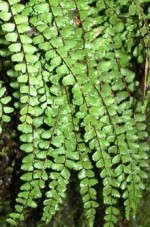
A native of rocky habitats in many parts of the world, maidenhair spleenwort has many subspecies that are associated with differences in the rock they grow on. The evergreen fronds grow in tufts and consist of round to oval leaf-like structures growing opposite each other on a slender stipe giving the frond a delicate airy appearance similar to those of maidenhair fern. The sori, reproductive structures, are spleen shaped and lie on the underside of the leaf like structures.
-
Type: Perennial fern
Color: No flowers; deep green fronds
Light: Partial shade
Soil: Average, moist, well-drained, limey
Hardiness: Zones 3-8
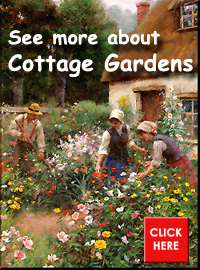 All of these plants like the well drained conditions that a garden wall can provide. They also reproduce themselves readily and so replace themselves or spread over the years. Since the prototype cottage garden developed in England, many plants will do well in the walls there were rain is abundant but not do well elsewhere. This means that a gardener will have to find similar plants that give the same look to the garden wall, a challenge for most of us who garden in the United States.
All of these plants like the well drained conditions that a garden wall can provide. They also reproduce themselves readily and so replace themselves or spread over the years. Since the prototype cottage garden developed in England, many plants will do well in the walls there were rain is abundant but not do well elsewhere. This means that a gardener will have to find similar plants that give the same look to the garden wall, a challenge for most of us who garden in the United States.